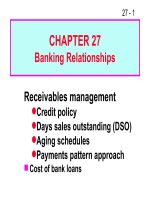FM11 Ch 04 Risk and Return_The Basics
Bạn đang xem bản rút gọn của tài liệu. Xem và tải ngay bản đầy đủ của tài liệu tại đây (177.31 KB, 48 trang )
4 - 1
CHAPTER 4
Risk and Return: The Basics
Basic return concepts
Basic risk concepts
Stand-alone risk
Portfolio (market) risk
Risk and return: CAPM/SML
4 - 2
What are investment returns?
Investment returns measure the
financial results of an investment.
Returns may be historical or
prospective (anticipated).
Returns can be expressed in:
Dollar terms.
Percentage terms.
4 - 3
What is the return on an investment
that costs $1,000 and is sold
after 1 year for $1,100?
Dollar return:
Percentage return:
$ Received - $ Invested
$1,100 - $1,000 = $100.
$ Return/$ Invested
$100/$1,000 = 0.10 = 10%.
4 - 4
What is investment risk?
Typically, investment returns are not
known with certainty.
Investment risk pertains to the
probability of earning a return less
than that expected.
The greater the chance of a return far
below the expected return, the
greater the risk.
4 - 5
Probability distribution
Rate of
return (%)
50150-20
Stock X
Stock Y
Which stock is riskier? Why?
4 - 6
Assume the Following
Investment Alternatives
Economy Prob. T-Bill Alta Repo Am F. MP
Recession 0.10 8.0% -22.0% 28.0% 10.0% -13.0%
Below avg. 0.20 8.0 -2.0 14.7 -10.0 1.0
Average 0.40 8.0 20.0 0.0 7.0 15.0
Above avg. 0.20 8.0 35.0 -10.0 45.0 29.0
Boom 0.10 8.0 50.0 -20.0 30.0 43.0
1.00
4 - 7
What is unique about
the T-bill return?
The T-bill will return 8% regardless
of the state of the economy.
Is the T-bill riskless? Explain.
4 - 8
Do the returns of Alta Inds. and Repo
Men move with or counter to the
economy?
Alta Inds. moves with the economy, so it
is positively correlated with the
economy. This is the typical situation.
Repo Men moves counter to the
economy. Such negative correlation is
unusual.
4 - 9
Calculate the expected rate of return
on each alternative.
.
∑
∧
n
1=i
ii
Pr = r
r = expected rate of return.
r
Alta
= 0.10(-22%) + 0.20(-2%)
+ 0.40(20%) + 0.20(35%)
+ 0.10(50%) = 17.4%.
^
^
4 - 10
Alta has the highest rate of return.
Does that make it best?
r
Alta 17.4%
Market 15.0
Am. Foam 13.8
T-bill 8.0
Repo Men 1.7
^
4 - 11
What is the standard deviation
of returns for each alternative?
.
Variance
deviation Standard
1
2
2
∑
=
∧
−=
==
=
n
i
ii
Prr
σ
σ
σ
4 - 12
σ
T-bills
= 0.0%.
σ
Alta
= 20.0%.
σ
Repo
= 13.4%.
σ
Am Foam
= 18.8%.
σ
Market
= 15.3%.
.
1
2
∑
=
∧
−=
n
i
ii
Prr
σ
Alta Inds:
σ = ((-22 - 17.4)
2
0.10 + (-2 - 17.4)
2
0.20
+ (20 - 17.4)
2
0.40 + (35 - 17.4)
2
0.20
+ (50 - 17.4)
2
0.10)
1/2
= 20.0%.
4 - 13
Prob.
Rate of Return (%)
T-bill
Am. F.
Alta
0 8 13.8 17.4
4 - 14
Standard deviation measures the
stand-alone risk of an investment.
The larger the standard deviation,
the higher the probability that
returns will be far below the
expected return.
Coefficient of variation is an
alternative measure of stand-alone
risk.
4 - 15
Expected Return versus Risk
Expected
Security return
Risk, σ
Alta Inds. 17.4% 20.0%
Market 15.0 15.3
Am. Foam 13.8 18.8
T-bills 8.0 0.0
Repo Men
1.7 13.4
4 - 16
Coefficient of Variation:
CV = Standard deviation/Expected return.
CV
T-BILLS
= 0.0%/8.0% = 0.0.
CV
Alta Inds
= 20.0%/17.4% = 1.1.
CV
Repo Men
= 13.4%/1.7% = 7.9.
CV
Am. Foam
= 18.8%/13.8% = 1.4.
CV
M
= 15.3%/15.0% = 1.0.
4 - 17
Expected Return versus Coefficient of
Variation
Expecte
d
Risk: Risk
:
Security return
σ
CV
Alta Inds 17.4% 20.0% 1.1
Market 15.0 15.3 1.0
Am. Foam 13.8 18.8 1.4
T-bills 8.0 0.0 0.0
Repo Men
1.7 13.4 7.9
4 - 18
T-bills
Coll.
Mkt
USR
Alta
0.0%
2.0%
4.0%
6.0%
8.0%
10.0%
12.0%
14.0%
16.0%
18.0%
20.0%
0.0% 5.0% 10.0% 15.0% 20.0% 25.0%
Risk (Std. Dev.)
Return
Return vs. Risk (Std. Dev.):
Which investment is best?
4 - 19
Portfolio Risk and Return
Assume a two-stock portfolio with
$50,000 in Alta Inds. and $50,000 in
Repo Men.
Calculate r
p
and σ
p
.
^
4 - 20
Portfolio Return, r
p
r
p
is a weighted average:
r
p
= 0.5(17.4%) + 0.5(1.7%) = 9.6%.
r
p
is between r
Alta
and r
Repo
.
^
^
^
^
^ ^
^ ^
r
p
= Σ w
i
r
i
.
n
i = 1
4 - 21
Alternative Method
r
p
= (3.0%)0.10 + (6.4%)0.20 + (10.0%)0.40
+ (12.5%)0.20 + (15.0%)0.10 = 9.6%.
^
Estimated Return
(More )
Economy Prob. Alta Repo Port.
Recession 0.10 -22.0% 28.0% 3.0%
Below avg. 0.20 -2.0 14.7 6.4
Average 0.40 20.0 0.0 10.0
Above avg. 0.20 35.0 -10.0 12.5
Boom 0.10 50.0 -20.0 15.0
4 - 22
σ
p
= ((3.0 - 9.6)
2
0.10 + (6.4 - 9.6)
2
0.20 +
(10.0 - 9.6)
2
0.40 + (12.5 - 9.6)
2
0.20
+ (15.0 - 9.6)
2
0.10)
1/2
= 3.3%.
σ
p
is much lower than:
either stock (20% and 13.4%).
average of Alta and Repo (16.7%).
The portfolio provides average return
but much lower risk. The key here is
negative correlation.
4 - 23
Two-Stock Portfolios
Two stocks can be combined to form
a riskless portfolio if ρ = -1.0.
Risk is not reduced at all if the two
stocks have ρ = +1.0.
In general, stocks have ρ ≈ 0.65, so
risk is lowered but not eliminated.
Investors typically hold many stocks.
What happens when ρ = 0?
4 - 24
What would happen to the
risk of an average 1-stock
portfolio as more randomly
selected stocks were added?
σ
p
would decrease because the added
stocks would not be perfectly correlated,
but r
p
would remain relatively constant.
^
4 - 25
Large
0
15
Prob.
2
1
σ
1
≈ 35% ; σ
Large
≈ 20%.
Return









